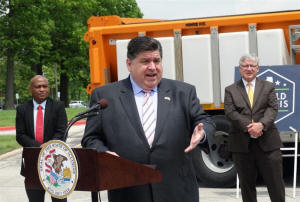Pritzker announces 6-year, $20.7 billion road, bridge improvement plan
 Send a link to a friend
Send a link to a friend
[May 20, 2021]
By GRACE BARBIC
Capitol News Illinois
gbarbic@capitolnewsillinois.com
 SPRINGFIELD – Gov. JB Pritzker announced
Wednesday the release of a six-year, $20.7 billion construction plan to
improve roads and bridges throughout the state, an annual process which
the Illinois Department of Transportation oversees to target
infrastructure spending. SPRINGFIELD – Gov. JB Pritzker announced
Wednesday the release of a six-year, $20.7 billion construction plan to
improve roads and bridges throughout the state, an annual process which
the Illinois Department of Transportation oversees to target
infrastructure spending.
The Highway Improvement Program, funded through the Rebuild Illinois
capital infrastructure plan passed in 2019, will reconstruct nearly
2,779 miles more miles of roads and 7.9 million square feet of bridge
deck between fiscal year 2022 and 2027, according to the governor’s
office.
The projects in the plan will create and support thousands of jobs,
“bolstering our pandemic recovery in one more way,” Pritzker said at a
news conference Wednesday in Springfield.
“This past year truly has brought home how important transportation
systems are in connecting the lives of our residents and our
communities, delivering food products to grocery stores, getting
essential workers to their jobs and transporting patients to the
hospital,” Pritzker said.

The Highway Improvement Program is a part of the larger $45 billion
Rebuild Illinois infrastructure plan, which was a bipartisan effort to
revitalize local economies that passed in the governor’s first year. The
plan invests in roads, bridges, railroads, universities, early childhood
centers and state facilities.
The projects outlined in the new multi-year plan will continue to create
and support hundreds of thousands of jobs, Pritzker said.
Overall, the Rebuild Illinois capital plan is expected to support around
540,000 thousand jobs over its lifespan. But there are currently no
estimates available on how many jobs the specific projects through the
Highway Improvement Program will create.
About $33.2 billion was earmarked in the initial release of the capital
plan for the transportation sector, with $25.3 billion specifically for
roads and bridges. Most of that funding came from an increase to the
state’s motor fuel tax, which was indexed for inflation each year, and
increases to state licensing fees.
The Illinois Department of Transportation said the plan includes $5.79
billion for highway reconstruction and preservation, $4.82 billion for
bridge improvements, $2.59 billion for strategic expansion, $1.43
billion for system support such as engineering and land acquisition, and
$1.21 billion for safety and system modernizations.
Acting Illinois Transportation Secretary Omer Osman said the projects
outlined in this plan are more than just projects.
“They will be the means for us to ensure our transportation system in
Illinois is reliable, safe, and provides economic opportunity for
everyone in Illinois – our guiding principle,” Osman said. “We will do
so in a way that provides equity, and with a workforce that reflects the
diversity in our greatest state, it remains the blueprint for how we
rebuild Illinois.”
For the upcoming fiscal year 2022, approximately $3.32 billion has been
identified to fund highway improvement projects.
[to top of second column]
|

Gov. JB Pritzker speaks outside of the Illinois
Department of Transportation building in Springfield Wednesday,
announcing the state's multi-year road and bridge plan. (Capitol
News Illinois photo by Peter Hancock)

Currently, some of the projects through Rebuild
Illinois include a $173 million multi-year investment in Interstate
57 which will continue next year and run in segments through 2027,
over $90 million worth of improvements to Interstate 55, and $40
million into Interstate 80 in northeastern Illinois, “making the
road smoother and safer amidst the region’s exploding intermodal
logistical growth,” Pritzker said.
A full list of the projects can be found on IDOT’s
website.
Pritzker said the multi-year plan will build on progress made over
the past two years, noting Rebuild Illinois has already improved
over 2,700 miles of state and local roadways and 290 bridges since
its 2019 passage.
“In every project we've made hundreds of safety improvements along
the way, enhancing right of way accessibility, funding railroad
crossing safety improvements and targeting locations tied to
crashes, to keep everyone as safe as possible along their travels,”
Pritzker said.
While the state’s gas tax is a major contributor to road and bridge
projects, it has seen a “significant” reduction in revenue because
of decreased consumption as a result of the COVID-19 pandemic,
according to IDOT.
IDOT said in its Highway Improvement Program report that the
decrease was somewhat offset by the Coronavirus Response and Relief
Supplemental Appropriations Act, one of the federal COVID relief
packages passed in 2021, which allocated $353 million to IDOT.
Of the federal COVID-19 relief funds that went to IDOT, $227 million
is included in the state highway program, the IDOT report stated.
The remaining COVID relief funds will go toward the multi-year
program for additional road and bridge projects.

IDOT officials said Wednesday that while the past year has been a
challenge, projects stayed on schedule and they did not have to make
any pandemic-related cuts.
Pritzker also announced that Amtrak will resume full passenger rail
service starting July 19.
The Chicago-Milwaukee partnership with Wisconsin will resume next
week, while the routes connecting Chicago to Quincy, Carbondale and
St. Louis will operate at full capacity by the mid-July date.
Capitol News Illinois is a nonprofit, nonpartisan
news service covering state government and distributed to more than
400 newspapers statewide. It is funded primarily by the Illinois
Press Foundation and the Robert R. McCormick Foundation. |